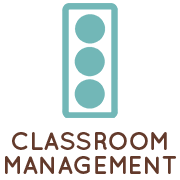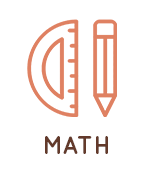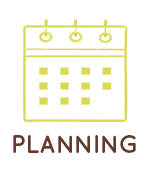
In the hustle and bustle of the upper elementary classroom, where every moment is precious and every standard is vital, it can be difficult to give every last educational concept the attention it deserves. This is especially true when a concept only has one or two standards addressing it. If it only has one standard in all of upper elementary, then it must not be too important, right?
… Or, maybe, the concept is just SO important that it only needs to be covered once to make a lasting impact on your kiddos! That’s what I’m choosing to believe, anyway, when it comes to symmetry. Maybe it’s my artistic side speaking, but I absolutely LOVE symmetry, and it actually hurts my feelings that this geometry concept doesn’t always get the attention it deserves.
For instance, when conducting my research for this blog post, I noticed a severe lack of educational resources and ideas that align with the Common Core State Standard 4.G.3: “Recognize a line of symmetry for a two-dimensional figure as a line across the figure such that the figure can be folded along the line into matching parts. Identify line-symmetric figures and draw lines of symmetry.”
It’s obviously important to ensure your kiddos are meeting CCSS, but once that goal is met, symmetry can sometimes fall to the wayside. It’s understandable, since there are simply SO MANY standards to get to, but symmetry really is important in its own right!
Let’s check out why it’s vital to students’ mathematical careers, then we’ll dive into seven symmetry activities that are sure to supplement your geometry lessons… Complete with a FREEBIE at the end!
Why Bother with Symmetry?
It’s not just important to cover symmetry in preparation for testing. Exploring symmetry helps students build fluency in math by reinforcing key concepts like congruence, transformations, and geometric properties. By working through engaging, hands-on symmetry activities and discussions, students develop a stronger understanding of math principles and develop fluency in applying them to new situations.
In addition, building a strong foundation in symmetry also helps students develop spatial reasoning skills, which are super important for understanding tougher geometric concepts and spatial relationships down the line. It’s a great way to help students learn to visualize shapes, identify patterns, and make predictions.
There’s also plenty of symmetry to be found in nature, too! This is certainly a neat way to make real-world connections with your kiddos, but beyond that, it also provides you with a great opportunity for an integrated curriculum with Earth science… Which, as you know, is like, my favorite thing ever. 😉
Okay, I think I’ve made my point. Let’s jump right into the activities!
Seven Symmetry Activities
1. Symmetry Art Swap
For this activity, you’ll want to provide individuals with graph paper and art supplies. Every student will begin by creating a “line of symmetry,” preferably horizontal or vertical to begin with, through the center of the page. Then, they can create a geometric design of their liking on ONE side of the mirror line. Of course, students should be given free agency with their designs, but you may want to encourage simpler designs to start with to allow kiddos to get the hang of the concept of symmetry.
Once students have created their designs on one side of the mirror line, have them swap their graph paper with a partner. The partner should then try to finish the design on the other side of the symmetry line! Since this is a pretty quick activity, I recommend having students repeat these steps a few more times. They can experiment with more complex designs and even add colors to be mirrored!
It’s not a bad idea either to encourage kiddos to find NEW partners every time, too. You don’t want them sticking to only their best friend—switch it up so everyone gets a diverse experience.
These symmetry art pieces can be shown off in the classroom or even a hallway bulletin board for a cute, easy display. Kiddos love showing off their work, and a splash of color in the halls always does wonders to brighten spirits!
2. Symmetry Manipulatives
Similar to the art swap above, this is another way for students to express their creativity by creating symmetrical designs. This time, though, they can only use manipulatives, such as pattern blocks, tangrams, or other physical geometrical shapes. It’s a bit more challenging than the art swap, since they don’t have complete freedom over the design; rather, they’re bound by the dimensions of the trapezoids and rhombuses and squares!
For this activity, have students sit across from one another and try to replicate one another’s designs using the pattern blocks. They should notice that the design is “mirrored” across a horizontal line of symmetry between them. Kiddos can even take turns making designs and creating a symmetrical version.

3. Symmetry Construction
If someone had told me back at university just how much I’d end up advocating for the use of toothpicks in the classroom, I would never have believed them… But, goodness, there’s no denying their myriad of uses! From fencing in animals to investigating camouflage, toothpicks are practically the backbone of hands-on activities.
And, as you’re sure to see, geometry is no exception! For this activity, have students use toothpicks to create symmetrical shapes. They can connect the toothpicks (or even popsicle sticks, if you prefer) at their endpoints to form geometric shapes, then identify and label the lines of symmetry within their creations—or you can have a partner do that part.
Challenge students to see how many lines of symmetry they can create within one design! Of course, in that case, you may want to ban circles… That might be a little too easy. 😉
4. Symmetry Scavenger Hunt
Listen, I know I recommend scavenger hunts, like, ALL the time, but you can’t blame me: they’re a perfect way to get students up and moving around, keeping them engaged while staying on-task!
For this activity, you’ll encourage kiddos to engage with a geometric scavenger hunt around the classroom, encouraging them to search for symmetrical objects or patterns. If you’d like, you can set out symmetrical pictures or the like ahead of time, but that’s not totally necessary; most classrooms are already chock-full of symmetry if you take the time to look!
Have students record their findings in a notebook or on a piece of paper as they move through the scavenger hunt. They should sketch all of the items they discover that are symmetrical and draw its lines of symmetry—for instance, they could draw the top-down view of a desk and include all of its symmetrical lines.
Once students have had enough time to scan the entire room, reconvene as a class and discuss their findings. Encourage productive discussion by asking questions, such as “Which objects have the most symmetrical lines?” and even deeper critical-thinking questions like “Would the entire classroom be symmetrical if it were mirrored? Why or why not?”
5. Symmetry Nature Walk
What’s this? Another opportunity to integrate curriculum? You got it! Add a helping of Earth science to your geometry unit by bringing students outside to make mathematical observations about nature.
Before heading outside, however, it’s time for a brainstorm sesh. As a class, discuss what kinds of symmetrical objects you may find outside! This is a good way to get students visualizing symmetry, which is a vital step to fully grasping geometry.
Then… Go outside! Just like with the scavenger hunt, have kiddos bring along paper in order to sketch images of the symmetrical objects they find along with their lines of symmetry. Some common examples they may find outside are leaves, flowers, and even insects!

After the adventure, reconvene in the classroom and have students share their findings. Ask more questions, like which objects outside had the most lines of symmetry, if there were any perfectly symmetrical objects (like circles) and so on.
This is a great opportunity for critical thinking, too! What observations can your students make about symmetry in nature? Is it common? Lots of wildlife is symmetrical to some degree, like humans. Why do they think this is? There are no right or wrong answers; the exercise is simply meant to get students thinking and visualizing!
6. Symmetry Stations
Next up, set up several different stations around the room that each center around a type of geometric shape, such as circles and ovals, triangles, parallelograms, and other shapes, like hearts, crosses, arrows, stars, and so on.
Each station should have around five “cards” each that have a different shape relevant to the station’s theme. For example, the triangle station should feature five different triangles of different sizes, each with varying amounts of lines of symmetry.
At each station, students should sketch the shapes on the cards on their own personal graph paper. Then, they can fold their paper to find lines of symmetry! The folding is an important part—not just because it’s hands-on, but also because it ensures that students are fully grasping the concept, specifically as it’s cited in CCSS 4.G.3: “Recognize a line of symmetry for a two-dimensional figure as a line across the figure such that the figure can be folded along the line into matching parts.”
Students should work together with groups or partners and go through all of the stations until they have “dissected” all of the cards at each center. Then, go over the answers as a class and discuss any questions or thoughts your kiddos may have.
7. Symmetry Assessment Activities
Now that your students have explored the nuances of symmetry, it’s time to check for understanding! Let’s start with a couple informal assessments.
Ticket-out-the-doors are a great method here, as you can simply draw half of a shape on the whiteboard and have students copy that shape onto a piece of scrap paper. Then, they would finish drawing its other side, taking care to keep the shape symmetrical. Once they turn in the paper, you can easily see right off the bat who has grasped the concept and who may still need a bit more help to properly visualize symmetry.
Another informal assessment to use here is Four Corners. Assign each corner of your classroom a number, one through four. This number will represent the lines of symmetry that a shape has. Then, draw a shape on the whiteboard and have students move to whichever corner of the room matches the number of lines of symmetry they think the shape has.
It’s definitely a plus to get students up and moving around, but if you’re pressed for time, no worries! Instead of using Four Corners, you can simply draw the shape on the whiteboard, then have your students raise up the number of fingers that match how many lines of symmetry the shape has.
If you’re finding your kiddos can still use a bit of practice, or if you just want to incorporate some review time, I’ve got you covered: check out this symmetry FREEBIE pulled straight from my fourth grade math workshop geometry unit! Click the pic below or the link above to download the worksheet. And, hey, if you like that, then you can find the full 4th Grade Math Workshop Geometry Unit here!
With this array of ideas to choose from, you and your kiddos are ready to grab your compass, sharpen your pencils, and take off on an adventure of symmetry! Don’t let this math concept just be an addendum to your geometry unit; give symmetry the attention it deserves in your upper elementary classroom.
And, as always, be on the lookout for more engaging, easy-to-implement ideas for your math and science students. While you’re here, sign up for my email list so you won’t miss out!

















